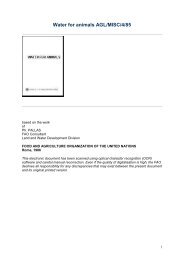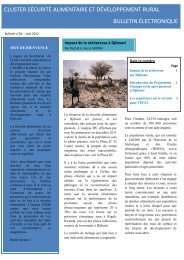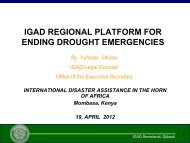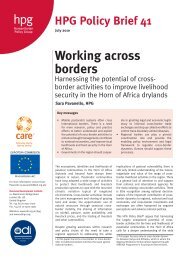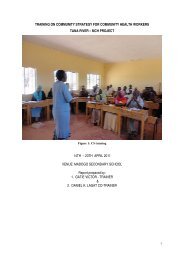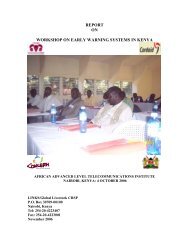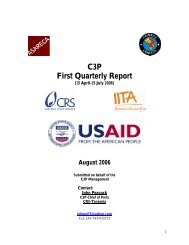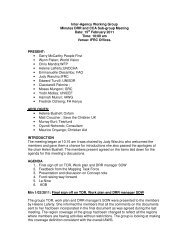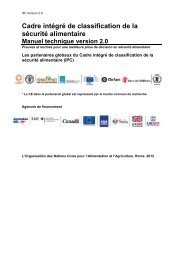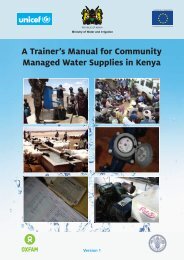Synthesis of Existing Knowledge and Experience on the Provision of ...
Synthesis of Existing Knowledge and Experience on the Provision of ...
Synthesis of Existing Knowledge and Experience on the Provision of ...
You also want an ePaper? Increase the reach of your titles
YUMPU automatically turns print PDFs into web optimized ePapers that Google loves.
will be given to pastoralists to encourage <strong>the</strong>m to practice agricultural activities side by side with<strong>the</strong>ir regular activities through <strong>the</strong> introducti<strong>on</strong> <str<strong>on</strong>g>of</str<strong>on</strong>g> small-scale irrigati<strong>on</strong>” (PASDEP, 2006: 70).At <strong>the</strong> same time, <strong>the</strong> document provides a wider <str<strong>on</strong>g>and</str<strong>on</strong>g> deeper discussi<strong>on</strong> <str<strong>on</strong>g>of</str<strong>on</strong>g> pastoral areas. Itrecognizes that mobility <str<strong>on</strong>g>and</str<strong>on</strong>g> livestock are central to <strong>the</strong> livelihood <str<strong>on</strong>g>and</str<strong>on</strong>g> that restricted mobilitydisrupts livelihoods. It also acknowledges that drought, poor market access, veterinary services <str<strong>on</strong>g>and</str<strong>on</strong>g>infrastructure, as well as water shortages <str<strong>on</strong>g>and</str<strong>on</strong>g> degraded rangel<str<strong>on</strong>g>and</str<strong>on</strong>g>s impede pastoral development. Itstates that “a proper underst<str<strong>on</strong>g>and</str<strong>on</strong>g>ing <str<strong>on</strong>g>of</str<strong>on</strong>g> pastoralism requires an underst<str<strong>on</strong>g>and</str<strong>on</strong>g>ing <str<strong>on</strong>g>of</str<strong>on</strong>g> <strong>the</strong> multidimensi<strong>on</strong>alreality <str<strong>on</strong>g>of</str<strong>on</strong>g> <strong>the</strong> pastoralist situati<strong>on</strong> today” (PASDEP, 2006: 195).The document states that <strong>the</strong> ab<str<strong>on</strong>g>and</str<strong>on</strong>g><strong>on</strong>ment <str<strong>on</strong>g>of</str<strong>on</strong>g> traditi<strong>on</strong>al grazing systems has had a serious impact<strong>on</strong> <strong>the</strong> natural resource base, resulting in overgrazing <str<strong>on</strong>g>and</str<strong>on</strong>g> l<str<strong>on</strong>g>and</str<strong>on</strong>g> degradati<strong>on</strong>. These are majorchallenges to pastoral livelihoods <str<strong>on</strong>g>and</str<strong>on</strong>g> represent c<strong>on</strong>straints to development at large. It fur<strong>the</strong>rrecognizes that formal instituti<strong>on</strong>s have a limited underst<str<strong>on</strong>g>and</str<strong>on</strong>g>ing <str<strong>on</strong>g>of</str<strong>on</strong>g> pastoral communal rangemanagement strategies, which has resulted in impediments to pastoral livelihoods. It states that inresp<strong>on</strong>se, “Government has set a policy that protects pastoral l<str<strong>on</strong>g>and</str<strong>on</strong>g>s, although it is not yetimplemented fully” (PASDEP, 2006: 195).Traditi<strong>on</strong>al management systems are recognized in <strong>the</strong> PASDEP. Within <strong>the</strong> policy statement, it isacknowledged that it is important to: 1) recognize traditi<strong>on</strong>al instituti<strong>on</strong>s <str<strong>on</strong>g>and</str<strong>on</strong>g> leadership, 2) promotelinkages between state <str<strong>on</strong>g>and</str<strong>on</strong>g> traditi<strong>on</strong>al governance, 3) develop policy innovati<strong>on</strong>s which build <strong>on</strong>traditi<strong>on</strong>al norms as well as state priorities, 4) develop participatory l<str<strong>on</strong>g>and</str<strong>on</strong>g> use <str<strong>on</strong>g>and</str<strong>on</strong>g> ownership policiesbased <strong>on</strong> communal l<str<strong>on</strong>g>and</str<strong>on</strong>g> management systems, 5) c<strong>on</strong>sult pastoral communities in designing <str<strong>on</strong>g>and</str<strong>on</strong>g>implementing development projects in <strong>the</strong>ir areas. It fur<strong>the</strong>r states that it is necessary to underst<str<strong>on</strong>g>and</str<strong>on</strong>g><str<strong>on</strong>g>and</str<strong>on</strong>g> balance <strong>the</strong> ec<strong>on</strong>omic advantages <str<strong>on</strong>g>of</str<strong>on</strong>g> interventi<strong>on</strong>s with <strong>the</strong> social costs. However, <strong>the</strong>re is noclear road map or plan for how to achieve <strong>the</strong>se aims.Strategies menti<strong>on</strong>ed to improve c<strong>on</strong>diti<strong>on</strong>s in <strong>the</strong> lowl<str<strong>on</strong>g>and</str<strong>on</strong>g>s include protecting <str<strong>on</strong>g>and</str<strong>on</strong>g> rehabilitatingrangel<str<strong>on</strong>g>and</str<strong>on</strong>g>s <str<strong>on</strong>g>and</str<strong>on</strong>g> developing water, but <strong>the</strong> relati<strong>on</strong>ship between water <str<strong>on</strong>g>and</str<strong>on</strong>g> <strong>the</strong> use <str<strong>on</strong>g>of</str<strong>on</strong>g> pasture in <strong>the</strong>lowl<str<strong>on</strong>g>and</str<strong>on</strong>g>s is not discussed except perhaps tangentially through menti<strong>on</strong>ing that <strong>the</strong> ab<str<strong>on</strong>g>and</str<strong>on</strong>g><strong>on</strong>ment <str<strong>on</strong>g>of</str<strong>on</strong>g>traditi<strong>on</strong>al grazing has c<strong>on</strong>tributed to rangel<str<strong>on</strong>g>and</str<strong>on</strong>g> degradati<strong>on</strong>, <str<strong>on</strong>g>and</str<strong>on</strong>g> that it is necessary to encouragetraditi<strong>on</strong>al natural resource management mechanisms.As was d<strong>on</strong>e for <strong>the</strong> PRSP, c<strong>on</strong>sultati<strong>on</strong>s were held with pastoralists to discuss <strong>the</strong> PASDEP <str<strong>on</strong>g>and</str<strong>on</strong>g>bring <strong>on</strong> board pastoral c<strong>on</strong>siderati<strong>on</strong>s prior to finalizing <strong>the</strong> program. Yet again <strong>the</strong> final documentbenefited little from this c<strong>on</strong>sultative process, <str<strong>on</strong>g>and</str<strong>on</strong>g> regi<strong>on</strong>al manifestati<strong>on</strong>s <str<strong>on</strong>g>of</str<strong>on</strong>g> <strong>the</strong> nati<strong>on</strong>al policy werevery similar to <strong>the</strong> nati<strong>on</strong>al level strategy (Pastoralist Forum Ethiopia, 2009).Rural Development Policies, Strategies <str<strong>on</strong>g>and</str<strong>on</strong>g> Instruments (RDPS)Since <strong>the</strong> agricultural sector has been earmarked as central to <strong>the</strong> growth <str<strong>on</strong>g>of</str<strong>on</strong>g> <strong>the</strong> nati<strong>on</strong>al ec<strong>on</strong>omy,it was recognized that a nati<strong>on</strong>al policy document was needed to guide development in rural areas<str<strong>on</strong>g>and</str<strong>on</strong>g> achieve rapid growth in <strong>the</strong> sector. This recogniti<strong>on</strong> culminated in <strong>the</strong> publicati<strong>on</strong> <str<strong>on</strong>g>of</str<strong>on</strong>g> <strong>the</strong> RDPSdocument, produced by <strong>the</strong> Ministry <str<strong>on</strong>g>of</str<strong>on</strong>g> Informati<strong>on</strong>. The development policies <str<strong>on</strong>g>and</str<strong>on</strong>g> strategiesoutlined in this 2001 document focus predominantly <strong>on</strong> crop cultivati<strong>on</strong> <str<strong>on</strong>g>and</str<strong>on</strong>g> <strong>the</strong> extensi<strong>on</strong> <str<strong>on</strong>g>and</str<strong>on</strong>g>promoti<strong>on</strong> <str<strong>on</strong>g>of</str<strong>on</strong>g> agriculture <str<strong>on</strong>g>and</str<strong>on</strong>g> irrigati<strong>on</strong> as a central way forward for ec<strong>on</strong>omic growth <str<strong>on</strong>g>and</str<strong>on</strong>g> foodsecurity in Ethiopia.In pastoral areas, short <str<strong>on</strong>g>and</str<strong>on</strong>g> medium term strategies focus <strong>on</strong> availing water for livestock producti<strong>on</strong>,with little menti<strong>on</strong> <str<strong>on</strong>g>of</str<strong>on</strong>g> how this should be approached. In <strong>the</strong> l<strong>on</strong>g term, however, pastoralism is seenas an unsustainable livelihood <str<strong>on</strong>g>and</str<strong>on</strong>g> sedentarizati<strong>on</strong> is encouraged with irrigated agriculture as a corelivelihood activity. The document states that “settlement in pastoralist areas is more than just achange <str<strong>on</strong>g>of</str<strong>on</strong>g> place; it is a change <str<strong>on</strong>g>of</str<strong>on</strong>g> lifestyle. It is transferring a pers<strong>on</strong> who used to be engaged in43



